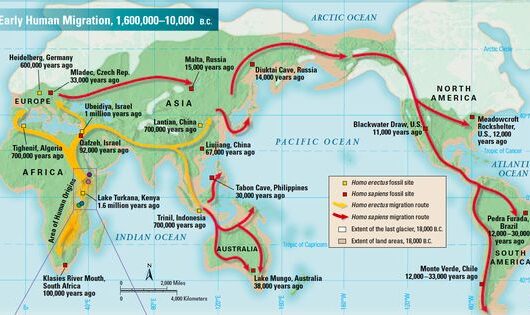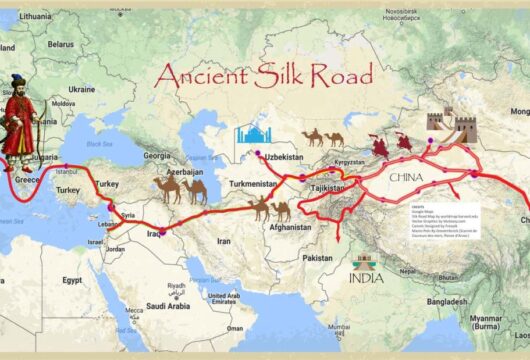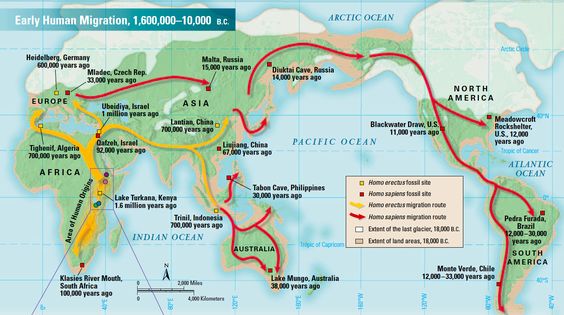Draft Statement
The Worldbuilding curriculum is the intellectual foundation of a global imaginary that transcends existing physical, political, and ideological boundaries. It seeks to respond to the question: what must all people know and how can we lay the groundwork for a new episteme of global future-flourishing. The curriculum draws from scholars whose work has emerged from a global, postcolonial, post-Western Enlightenment-centered experience and is situated within interdisciplinary humanities and social sciences. It examines several broad categories of investigation in order to outline, question, and develop deeper understandings of critical domains affecting the future of the world:
- Culture defines the complex and diverse structures, relationships, and meanings that govern individual and group human interaction, whose emergence in deep prehistory signified a major evolutionary milestone of the genus Homo.
- Communication comprises all forms of data and information flows, from the genetic code to the binary digit, as well as the media through which they have been transmitted and archived, past and present.
- Technics includes the total sum of skills, techniques, methods, and processes that have been used by humans to adapt to the environment, from the emergence of the genus Homo some 2.3 million years ago to the latest digital mechanisms and networks employed by humans in the present.
- Exchange encompasses the broad range of interactions between various life forms, vectors, and objects, including sentient and non-sentient actants, both as they have evolved on a planetary scale and as they exist in the cosmos.
- Ideas and Ideals traces the origins and development of the noosphere, the third stage of planetary evolution, from inanimate matter, AKA the geosphere, to the biological layer, AKA the biosphere, to the emergence of sentient beings, especially the human whose consciousness and environmental interventions — what geologist Peter Haff has termed the “technosphere” — have transformed the other two spheres to up to the current epoch, termed the Anthropocene, and whose impact on the environment threatens a new mass species extinction.
Adopting the ecosophy of Felix Guattari as a framing device, the Worldbuilding curriculum is intended to foster the following outcomes:
- A mental ecology that repairs the psychological damage that centuries of anthropocentric and colonalized subjectivities have had on individual consciousness and enables the potential to envision a sustainable, equitable future-flourishing across the globe.
- A social ecology that dismantles systems of oppression and exploitation, past and present, that have divided the planet and its inhabitants and depleted its resources and instead preserves ancient and contemporary wisdom and cultures and provides structures for an intersubjective future-flourishing that privileges no individual or community over another but harmonizes multilayered systems that respond to a multipolar set of concerns.
An environmental ecology that heals the metabolic rift with nature at the root of the current ecological crisis, which has been exacerbated by human intervention into the ecosystems of the planet and threatens to render it uninhabitable, and instead promotes a series of regenerative practices to ensure a future-flourishing for the environment that is sustainable and equitably distributed.
Worldbuilding Curriculum Module I – The Long Duree
Module I is the curriculum’s foundation, starting with the Earth’s material history (i.e, the geosphere), the emergence of life (i.e., the biosphere), and the emergence of hominids and the subsequent development of culture as part of the evolutionary process (i.e., the noosphere).
The Geological Time Scale (Geosphere, Biosphere, Noosphere)
| Eon | Time (mya) | Description |
| Hadean | 4,540–4,000 | The Earth is formed out of debris around the solar protoplanetary disk. There is no life. Temperatures are extremely hot, with frequent volcanic activity and hellish-looking environments (hence the eon’s name, which comes from Hades). The atmosphere is nebular. Possible early oceans or bodies of liquid water. The Moon is formed around this time probably due to a protoplanet’s collision into Earth. |
| Archean | 4,000–2,500 | Prokaryote life, the first form of life, emerges at the very beginning of this eon, in a process known as abiogenesis. The continents of Ur, Vaalbara and Kenorland may have existed around this time. The atmosphere is composed of volcanic and greenhouse gases. |
| Proterozoic | 2,500–541 | The name of this eon means “early life”. Eukaryotes, a more complex form of life, emerge, including some forms of multicellular organisms. Bacteria begin producing oxygen, shaping the third and current of Earth’s atmospheres. Plants, later animals and possibly earlier forms of fungi form around this time. The early and late phases of this eon may have undergone “Snowball Earth” periods, in which all of the planet suffered below-zero temperatures. The early continents of Columbia, Rodinia and Pannotia, in that order, may have existed in this eon. |
| Phanerozoic | 541–present | Complex life, including vertebrates, begin to dominate the Earth’s ocean in a process known as the Cambrian explosion. Pangaea forms and later dissolves into Laurasia and Gondwana, which in turn dissolve into the current continents. Gradually, life expands to land and familiar forms of plants, animals and fungi begin appearing, including annelids, insects and reptiles, hence the eon’s name, which means “visible life”. Several mass extinctions occur, among which birds, the descendants of non-avian dinosaurs, and more recently mammals emerge. Modern animals—including humans—evolve at the most recent phases of this eon. |
(Source: https://en.wikipedia.org/wiki/History_of_Earth#Geologic_time_scale)
The Five Great Mass Extinctions
The Sixth Mass Extinction?
Ecce Homo

(Source: Pinterest)
- Lower Paleolithic (3 million – 300,000 BCE): The emergence of homo erectus
- Middle Paleolithic (300,000 – 50,000 BCE): The emergence of homo sapiens
- Upper Paleolithic (50,000 – 12,000 BCE): The emergence of behaviors and technological innovations that constitute the cognitive and cultural foundations of modern humans
- Epipaleolithic (20,000 – 10,000 BCE): Prehistory of the Levant (Middle East): Hunter-gatherer societies, rudimentary stone tools, nomadic
- Mesopaleolithic (20,000 – 8,000 BCE): Prehistory of Southeast Asia and Europe: Hunter-gatherer societies, use of pottery and textiles
- “The Cradle of Civilization” (10,000 – 4500 BCE): Introduction of farming and domesticated animals, refinement of tools, built structures
- Calcolithic (Copper Age): Technological development of metallurgy, barbarian tribes
- Discovery of alloys, protowriting, development of governance systems
- Development of iron and steel tools and weaponry, written language systems, beginnings of the historical record
Worldbuilding Curriculum Module II – World History
Module II builds on the foundation of Module I to trace the development of human culture and its articulations across space and time. It begins by recapping the advancements of humankind in the Bronze and Iron Ages and then surveys the development of world cultures in antiquity. It subsequently investigates what Michel Foucault terms “a history of the present” in the form of a genealogy of diverse human cultures leading to the emergence of a global imaginary.
The Ancient World


Ancient History
- Fertile Crescent
- Sumer
- Mesopotamia
- Phoenicia
- Akkadian Empire
- Ancient Egypt
- Minoa and Mycenae (2000 – 1100 BCE)
- Etruscan
- Ancient Greece and Rome
- Byzantium
- Land of Punt
- Ethiopia
- Eritrea
- Macrobia
- Tribal confederations and ancient states: the Xiongnu, Scythia, Cimmeria, Sarmatia, Hunnic Empire, Chorasmia, Transoxiana, Sogdiana, Xianbei
- China
- Japan
- Korea
- Mongolia
- Indus Valley Civilization
- Mahajanapadas Kingdoms
- Maurya Empire
- Adena
- Hopewell
- Mississippian
- Puebloans
- Olmecs
- Zapotec
- Mayan
- Tiotihuacan
- Toltecs
- Norte Chico
- Sechin
- Chavin
- Nazca
- Lima
- Tiwanaku
- Dhar Tichitt
- Oualata
- Nok
- Senegambia
- Djennei-Djenno
- Bantu
- Ghanian Empire
Southeast Asia and Oceana
- Vietnam
- Austronesians
- Australia
- Polynesia
- Funan
- Taruma Kingdom
Post Classical (500 – 1500 CE)
- Africa
- Americas
- Oceania
- East Asia
- South Asia
- Southeast Asia
- Europe
- Africa
- Americas
- Oceania
- East Asia
- South Asia
- Southeast Asia
- Europe
- Africa
- Americas
- Oceania
- East Asia
- South Asia
- Southeast Asia
- Europe
Worldbuilding Curriculum Module III – Categorical Studies
Modules I and II of the Worldbuilding curriculum provide a foundational understanding of world history, the former in terms of the planet’s physical evolution and the latter in terms of the development of humankind’s emergence and ultimate dominion over it via the system of interventions geologist Peter Haff terms the “technospere.”. The third module of the Worldbuilding curriculum investigates broad categories that lay the groundwork for imagining a new episteme of global future-flourishing.
THE CONCEPT OF CULTURE
REFERENCES
Abu-Lughod, Janet. Before European Hegemony: The World System 1250-1350 A.D. Oxford, UK/New York: Oxford University Press, 1991.
Adorno, Theodor and Max Horkeimer. Dialectic of Enlightenment. Palo Alto, CA: Stanford University Press, 2007.
Appadurai, Arjun. Modernity at Large: Cultural Dimensions of Globalization. Minneapolis, MN: University of Minnesota Press, 1996.
—. The Future as Cultural Fact: Essays on the Global Condition. London/New York: Verso, 2013.
Bateson, Gregory. Steps to an Ecology of Mind: Collected Essays in Anthropology, Psychiatry, Evolution, and Epistemology. Chicago: University of Chicago Press, 2000.
Becker, Howard. Art Worlds. Berkeley: University of California Press, 2008.
Benjamin, Walter. Illuminations. New York: Mariner Books, 2019.
Bollier, David, and Silke Helfrich. Free, Fair, and Alive: The Insurgent Power of the Commons. Gabriola Island, CA: New Society Publishers, 2019.
Bourdieu, Pierre. Distinction: A Critique of the Judgment of Taste. New York: Routledge, 1986.
Cesaire, Aime. Discourse on Colonialism. New York: Monthly Review Press, 2000 (1972).
Chakrabarty, Dipesh. Provincializing Europe: Postcolonial Thought and Historical Difference. Princeton, NJ: Princeton University Press, 2007.
—. The Climate of History in a Planetary Age. Chicago, IL: University of Chicago Press, 2021.
Clifford, James. The Predicament of Culture: Twentieth-Century Ethnography, Literature, and Art. Cambridge, MA: Harvard UP, 1988.
De Sousa Santos, Boaventura. Epistemologies of the South: Justice Against Epistemicide. London, New York: Routledge, 2016.
—. The End of Cognitive Empire: The Coming Age of Epistemology of the South. Durham, NC: Duke University Press, 2018.
Davidson, Basil. African Civilization Revisited: From Antiquity to Modern Times 2nd edition. Trenton, NJ: Africa World Press, 1990.
Debray, Regis. Media Manifestos: On the Technological Transmission of Cultural Forms. London/New York: Verso, 1996.
Diamond, Jared. Guns, Germs, and Steel: The Fates of Human Societies. New York: W.W. Norton, 1997.
—. Collapse: How Societies Choose to Fail or Succeed Revised edition. New York: Penguin, 2011.
Durkheim, Emil. The Elementary Forms of Religious Life. New York: Free Press, 1995 (1912).
Escobar, Arturo, Designs for the Pluriverse: Radical Interdependence, Autonomy, and the Making of Worlds. Durham, NC: Duke University Press, 2017.
—. Pluriversal Politics: The Real and the Possible. Durham, NC: Duke University Press, 2020.
Fanon, Frantz. The Wretched of the Earth. New York: Grove Press, 2005 (1961).
Foster, John Bellamy, Richard York, and Brett Clark. The Ecological Rift: Capitalism’s War on the Earth. New York: Monthly Review Press, 2010.
Foucault, Michel. “Society Must Be Defended”: Lectures at the Collège de France, 1975–1976. New York: Picador, 2003.
—. The Birth of Biopolitics: Lectures at the Collège de France, 1978–1979. New York: Picador, 2003.
Freire, Paolo. Pedagogy of the Oppressed. New York: Penguin, 2017.
Fry, Tony. Design Futuring: Sustainability, Ethics, and New Practice. Oxford, UK/New York: Berg, 2009.
Fry, Tony, and Adam Nocek, eds. Design in Crisis: New Worlds, Philosophies, and Practices. London, NewYork: Routledge, 2021.
Geertz, Clifford. The Interpretation of Cultures. New York: Basic Books, 1977.
Glazer, Nathan and David Riesman. The Lonely Crowd. New Haven, CT: Yale University Press, 2001.
Guattari, Felix. The Three Ecologies. London/New York: Continuum, 2008 (1989).
Habermas, Jurgen. The Structural Transformation of the Public Sphere. Cambridge: MIT Press, 1991.
Haff, Peter. 2014. “Technology as a Geological Phenomenon: Implications for Human Well-Being,” pp. 301-302 in A Stratigraphical Basis for the Anthropocene, C. N. Waters et. al. (London: Geological Society, Special Publications).
Haraway, Donna. Staying with the Trouble: Making Kin in the Chthulucene. Durham, NC: Duke University Press Books, 2016.
Hegel, G.W.F. Phenomenology of Spirit. Oxford, UK: Oxford University Press, 1977.
Innis, Harold. Empire and Communications. Toronto, CA: University of Toronto Press. 1972 (1950).
Iheka, Cajetan. Naturalizing Africa: Ecological Violence, Agency, and Postcolonial Resistance in African Literature. Cambridge, UK: Cambridge University Press, 2018.
Kant, Immanuel. “What is Enlightenment? In Political Writings. Cambridge, UK: Cambridge University Press, 1991.
Latour, Bruno. Reassembling the Social: An Introduction to Actor-Network Theory. Oxford, UK/New York: Oxford University Press, 2007.
—. Down to Earth: Politics in the New Climatic Regime. Boston: Polity, 2018.
Levi-Strauss, Claude. Wild Thought. Chicago: University of Chicago Press, 2021.
Li Minqi. China and the 21st Century Crisis. London: Pluto Press, 2015.
Malinowski, Bronislaw. Argonauts of the Western Pacific. New York: Routledge, 2014.
Manthia, Diawara. African Cinema: Politics and Culture. Bloomington, IN: University of Indiana Press, 1992.
—. African Film: New Forms of Aesthetics and Politics. Munich, DE: Prestel, 2010.
Marx, Karl. The Marx-Engels Reader. New York: W. W. Norton & Company, 1978.
Newell, Stephanie. Histories of Dirt: Media and Urban Life in Colonial and Postcolonial Lagos. Durham, NC: Duke University Press, 2020.
Pasztory, Esther. Thinking With Things: Toward a New Vision of Art. Austin, TX: University of Texas Press, 2005.
Poggioli, Renato. Theory of the Avant Garde. Cambridge, MA: Belknap Press of Harvard University Press, 1981.
Rabinow, Paul. Reflections on Fieldwork in Morocco. Berkeley: University of California Press, 2007.
Robertson, Robbie. The Three Waves of Globalization: A History of a Developing Global Consciousness. London: Zed Books, 2002.
Rousseau, Jean-Jacques. Of The Social Contract and Other Political Writings. New York: Penguin, 2012.
Sahlins, Marshall. Stone Age Economics. Chicago, IL: Aldine-Atherton, 1972.
Said, Edward. Orientalism. New York: Pantheon, 1978.
Samson, Paul R. and David Pitt, eds. The Biosphere and Noosphere Reader: Global Environment, Society, and Change. London/New York: Routledge. 1999.
Sennett, Richard. The Fall of Public Man. New York: Norton, 1992.
Shose, Kessi, Zoe Marks, and Elelwani Ramugondo. “Decolonizing African Studies.” Critical African Studies, 12:3, pp. 271-282.
Simmel, Georg. On Individuality and Social Forms. Chicago: University of Chicago Press, 1972.
Smith, Adam. The Wealth of Nations. New York: Penguin, 1982.
Spivak, Gayatri. “Can the Subaltern Speak?” In C. Nelson and L. Grossberg (eds.), Marxism and the Interpretation of Culture. Macmillan Education: Basingstoke, 1988, pp. 271-313.
Steger, Manfred B. The Rise of the Global Imaginary: Political Ideologies from the French Revolution to the Global War on Terror. Oxford, UK/New York: Oxford University Press, 2008.
Tassinari, Virginia, and Eduardo Staszowski. Designing in Dark Times: An Arendtian Lexicon. London, New York: Bloomsbury, 2020.
Taylor, Charles. Modern Social Imaginaries. Durham, NC: Duke University Press. 2003.
Victor Turner. The Forest of Symbols. Ithaca, NY: Cornell University Press, 1970.
Voltaire, Candide, or the Optimist. New York: Penguin, 2006.
Wallerstein, Immanuel. World-Systems Analysis: An Introduction. Durham, NC: Duke University Press, 2004.
—. The World System and Africa. Brooklyn, NY: Diasporic Africa Press, 2017.
Weber, Max. The Protestant Ethic and the Spirit of Capitalism. New York: Penguin, 2002.
Whyte, William H. The Organization Man. Philadelphia: University of Pennsylvania Press, 2002.
—. The Social Life of Small Urban Spaces. New York: Project for Public Spaces, 2001.
Wolf, Eric. Europe and the People Without History 2nd edition. Oakland, CA: University of California Press, 2010 (1982).
ONLINE RESOURCES
VIDEOS
Dipesh Chakrabarty “The Anthropocene and Historical Time” https://vimeo.com/551628982
Social Research vol 88(1) panel on The Commons https://vimeo.com/event/1050271

